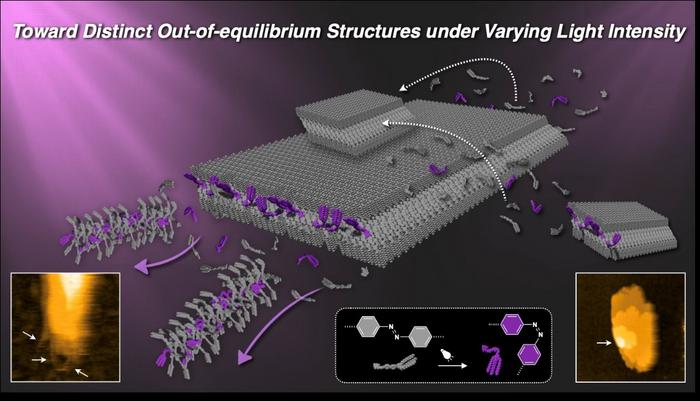In the future, there could be materials that can reconfigure themselves on demand, adapting their structure and properties like living organisms.
A team of Japanese scientists have created a supramolecular polymer system that transforms into 1D, 2D, or 3D structures by adjusting light intensity.
The Chiba University researchers say this development could lead to a new generation of highly adaptable “smart” materials. The current materials are generally static once their form is established.
This work demonstrates a non-biological system that changes its structure or state depending on the amount of energy it receives, much like living organisms.
 How dimensionally distinct supramolecular structures arise under different light intensities. Credit: Assistant Professor Kenta Tamaki from Chiba University.
How dimensionally distinct supramolecular structures arise under different light intensities. Credit: Assistant Professor Kenta Tamaki from Chiba University.
Changes in light intensity
The study addresses a core challenge in materials science: creating out-of-equilibrium molecular assemblies — structures that exist outside their stable thermodynamic state.
While previous studies have achieved such states using external energy, few systems could adaptively respond to how much energy was input.
“Our group has long been pursuing unique research aimed at controlling the nano- to mesoscale morphologies of molecular assemblies using light,” said Professor Shiki Yagai.
“However, we had not yet realized an out-of-equilibrium system that, much like living organisms, changes its structure or state depending on the amount of energy it receives,” Yagai added.
The innovation lies in a specially designed molecule that combines a light-responsive “azobenzene” unit with a “barbituric acid-based merocyanine” core.
This unique combination allows the material to exhibit supramolecular polymorphism – the ability to form different assembly structures – triggered and controlled by light.
Initially, the synthesized molecules self-assemble into 1D coiled nanofibers. When left undisturbed under ambient light, these naturally transition into more thermodynamically stable 2D nanosheets. This is where the light-intensity magic begins.
Adaptive materials
When the 2D nanosheets were exposed to strong ultraviolet (UV) light, researchers observed a dramatic reversal.
The material transformed back into 1D linear nanofibers.
High-speed atomic force microscopy (HS-AFM) revealed that this change was due to the azobenzene unit’s photoisomerization, which disrupted the hydrogen bonds holding the 2D sheets together.
Interestingly, this transformation occurred specifically along certain facets of the nanocrystals that were more exposed to light.
Even more remarkably, when exposed to weak UV light, the system took a completely different path.
Transmission electron microscopy (TEM) and AFM observations showed that smaller nanosheets disassembled, while larger ones began to grow vertically, forming intricate 3D nanocrystals.
This process, known as Ostwald ripening, involves smaller structures dissolving and redepositing onto larger ones. HS-AFM beautifully captured these localized growth events, including secondary nucleation and epitaxial growth.
“This out-of-equilibrium supramolecular system paves the way for developing highly functional materials that can alter their states in response to external stimuli, much like living systems,” concluded Yagai.
“Looking ahead, by incorporating photoactive, electroactive, or even catalytic functions directly into the molecular design, it may be possible to create systems whose functional performance spontaneously adapts to environmental changes.”
This research opens the door to a new generation of smart materials – from self-healing surfaces and dynamic sensors to adaptable drug-delivery systems and energy-harvesting technologies – that can respond to their surroundings.
The study was published in the journal Chem on November 17.
